Deer can sometimes grow hooves that are much longer than normal. Long hooves in deer is not common because I’ve seen reports from many different places over the years, but it’s not something that hunters will commonly see in the field. Just this week, I received an email that contained photos of a white-tailed doe than had long hooves (it was actually just her front left hoof and back right hoof).
This condition is referred to as foundering and I believe the term comes from the word “floundering” because under extreme conditions the animal appears to be floundering around as it walks. From reviewing the literature, there appears to be three main reasons for long hoof growth in deer, but all are related to diet.
Why do Deer Founder?
A deer that exhibits foundering is taking in way too many carbohydrates. Either this is a problem directly related to the forage that the animal is eating or it has to do with the way the deer is processing its food. More often than not, it has to do with what the deer is eating. A diet high in corn or protein pellets contributes to foundering. Corn, of course, is primarily carbohydrates.
Hoof tissue is very similar to antler tissue. If you are feeding protein to grow larger bodied deer and larger antlers then you are also feeding to grow deer with longer hooves. Foundering is almost always the result of a deer consuming too many carbohydrates in the diet too fast.
The result is a buildup of acid in the rumen, which kills the bacteria that digest carbohydrates. This process then results in an increasing pH in the blood that can hurt or possibly even kill the deer from acidosis.
Foundering is a result of these physiological changes within hooved animals. The technical term for problem is laminitis, and refers to the physical separation of the hoof wall and rotation of the coffin bone. So rather than a deer walking on the ends of its hooves, it walks on the sides of its hooves. This causes improper wear and hooves lengthen.
Photos: Deer with Foundered Hooves
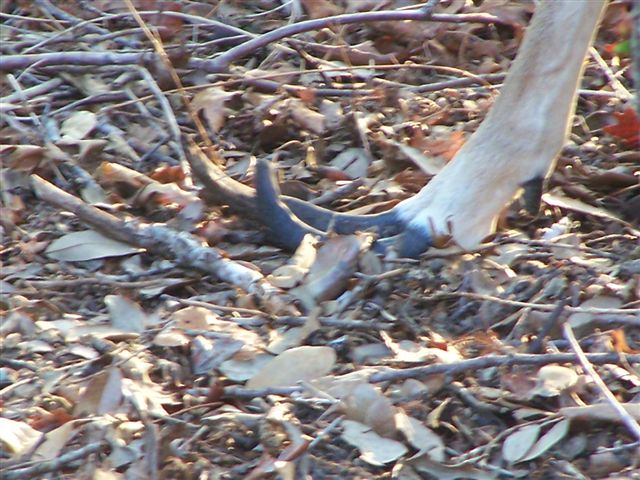
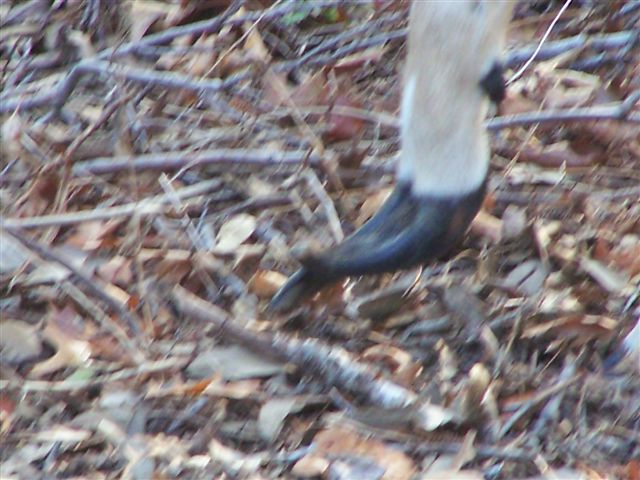
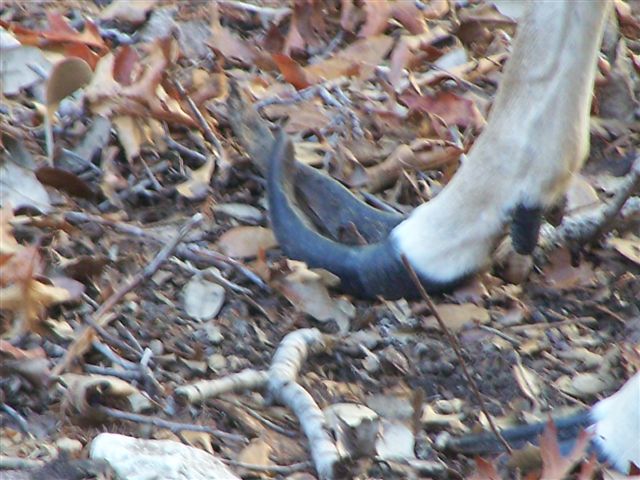
Foundering and Deer Mobility
White-tailed deer than have foundered, long hooves will often walk on the backs of their hooves because the acid buildup agitates the growth plate in their hooves. As a result of the deer attempting to ease the pain, the hooves grow longer than normal because the hooves do not have proper contact with the ground.
Without proper contact hoof-ground contact, the hooves do not wear down as they normally would. This problem can be exacerbated on “soft” soils such as clay and sand because hoof wear in deer is already decreased in these areas.
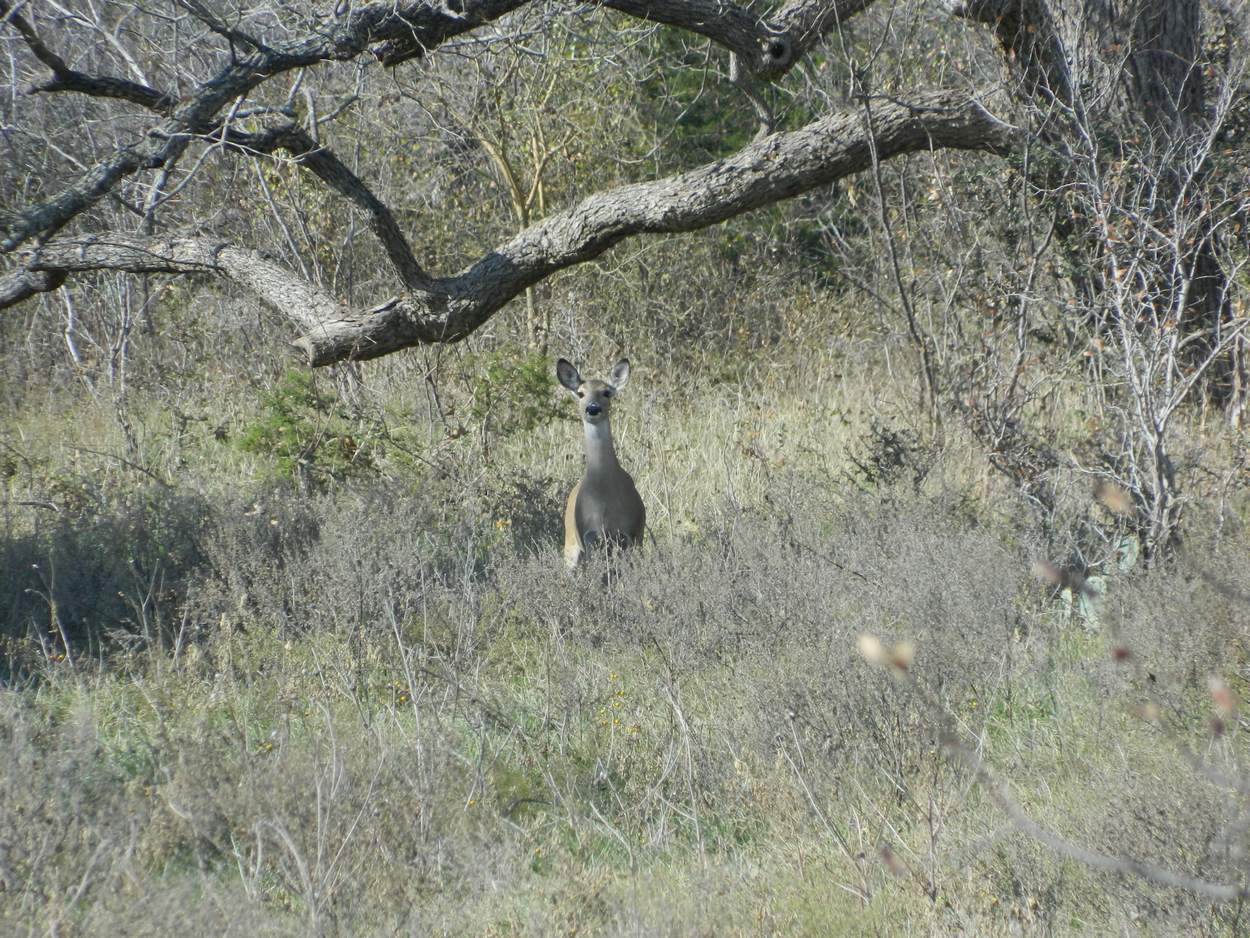
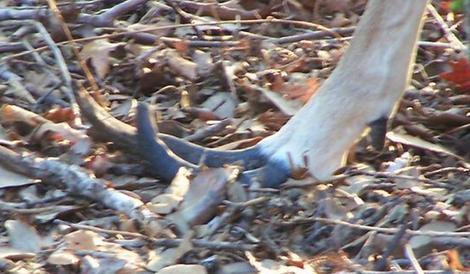
Also, you may want to check out coffin bones. Horses have them and so do deer (I think). Coffin bone breaks can be injuries or diet related as well.
Is this fake!!! LOL, how can a deer possibly have that long of hooves!? This is not real at all, is it? How did you get a pic of just its feet?
Foundering in deer is real. Not everyone will see deer with long hooves, but they are not all that uncommon.
Is the meat still safe for human consumption?
Yes, it is safe to eat.
This is most definitely real! We just shot a doe on Saturday that had foundered hooves like this on all four of its feet.
I saw a doe like this in August 2009 in Pipe Creek, Texas, near the Medina River. The doe was with a fawn and seemed very tame. It seemed more like the front hooves were molting rather than extra long, and she seemed to be walking normally, without pain, but with a floppy covering on top of her hooves. We thought it was due to the drought conditions at that time. I have been puzzled by it ever since. Thanks for the information.
I HAD to Google this because we just visited a camp where they had one deer harvested which had these crazy long hooves! It was hanging beside some very healthy deer, and in comparison, its hide was much paler and it was pretty gangly. We’ve been hunting the area for decades and have never seen anything like it.
Nov 21, 2009 – North Central Idaho, utside Lewiston. I shot a doe with all 4 hooves curled. This is very real.
Thanks for providing this information as I was very curious of the cause of these odd deer hooves, and also if the meat was OK to eat.
On November 27, 2009, in Hamilton County, Florida: It is definitely real! My son shot a whitetail doe this morning and all 4 hooves were curled up just like the photo. The deer showed no other signs of anything else being physically wrong.
The word “founder” is actually the older term. “Flounder” was a modification of the former. Foundering is a condition that any person familiar with horses knows (and probably winces at the thought of). Horses and similar animals can present malformations of the hoof similar to what is seen in your photos. This condition, if allowed to progress (it is difficult to manage), is typically cause for humane euthanizaiton. The likely reason any deer with this problem would look unhealthy is because they would be unable to move well, which I’m assuming would mean that they would have problems accessing food/competing for resources.
Is it only does that are supposed to “founder”? I’ve never heard of it before. I was just reading to do a report on deer management and it was funny how I came across this article because my uncle shot a black tailed buck this last deer season in Northern California on our private property. The hooves on that deer were very long also, but I dont think that they curled like that. I thought it was because of genetics, but I guess not.
I shot a doe this past gun season that had long toes on only one foot. She had been walking with a very bad limp as I thought she was injured and decided to harvest her. On examination of her limp leg I discovered that her hoove had been injured some time ago and since then healed up.
I shot a 7 point buck this deer season that had all 4 feet that had abnormally long hoofs. His horns were on the way down, as he aged at 7 to 8 yrs old. The buck was very skinny and in bad shape.
There’s a white-tailed doe in my back yard right now with 4 foundered hooves. I took movies of her walking. Never saw anything like it before.
YES! Absolutely! I live in a San Antonio suburb and noticed a white-tailed deer walking and it seemed as though her hooves were broken, but after closer examination, her hooves were long and curled upward.
Yes it’s real. I just saw a deer like this a few minutes ago and wondered why its hooves were like that. Now I know!
Hello, I live in Florida and we have a young doe with two fawns coming into the yard and the doe has foundering hooves. From what I have read on a couple of web sites, can anything be done to help her it’s all four hooves?
Should I have my vet try to tranquilize and treat her or is she going to continue to suffer? Is this painful? Any information would be appreciated.
A vet will be unable to treat her. The problem stems from her diet, and she walks on the back of her hooves to ease the pain. As a result, her hooves do not wear as they should, which wears them down, but instead they continue to grow. The problem is diet related.
What can I do to help the doe? Anything I can feed it that will help?
We have a horse farm behind us … is this from eating the feed for horses they have been known to get into the sweet feed they feed their horses?
We have a huge deer population here and so far this is a first
What about the fawns of this doe will they get this as well?
Our hunting party just shot an 8 point buck that had foundered hooves. Besides the long hooves, it had cracks at the base of the foot with swollen lower legs. We hunt in an area with soft sandy soil with lots of corn, bean, and alfalfa fields.
I am curious about a buck my husband just got. The hooves are white? Anyone else ever heard or seen of this before? I’ve just never seen anything like it
We live on Vancouver Island, Canada. Over the years we have seen many deer around our yard with this problem. Just tonight there was one with the left front hoof elongated about three inches. She has twin fawns tagging along.
This is VERY real! I just saw a deer on my street with theses hooves on all its feet. Thats why I was looking it up. Never seen this before today. Doesn’t look very comfortable.
Thanks for article. Just searched this topic on the web as my buddy took a young doe this weekend here in Michigan which exhibited this condition on all 4 hooves. Never seen anything like it in the the field before.
We shot a deer this yr… it was in verona state game area… not 1 or 2 feet had this long hoof, but all 4 did… her head was twice the size of an average doe… and her neck i could almost get my fingers around, it was so small… we didnt trust the deer at all… needless to say we wasted a tag and… never before… we scrapped the deer… it actually smelt bad… anyone seen that or can give a reason as to why head, neck and smell was there? iam very curious and very concerned of the verona state game area in Michigan thumb…
All hoofed animals are designed to be living on a high fiber, low sugar diet that they receive from natural wild grasses. Once we interfere with this by introducing high sugar, low fiber feed there lamina become immediately susceptible to attack. Once the lamina lose there incredibly powerful ability to keep the coffin bone and hoof wall securely connected due to the rich feed, then the feet fall apart starting with the ripping of the lamina to the eventual giving up of there essential job resulting in founder.
My son kill a 4 point buck on 01/16/14 just north of White Castle Louisiana, which is south of Baton Rouge. All 4 hooves were very long and curved as in the pictures above. I talked with a biologist from the LA Wildlife and Fisheries and he told me that this deer probably had a case of EHD, (blue tongue). Everything else on the deer was normal. Looked like a very healthy deer. The area we hunt has lots of oak, pecan, and other hardwood trees. I was reading the other comments and there were no mention of EHD causing this.
Despite having grown up around deer, I had never heard of foundering before… but an hour ago, my wife and I looked out the back window and were blown away to see a deer in the yard with what looked like elves’ shoes. We thought it had broken all four legs at first… then thought maybe it was deformed. So we searched and found this. Very, very strange. The deer seems otherwise healthy. We’re in southeastern PA.
Is there a commercial feed for the foundering problem with red deer. This problem just showed up in my 4-yr old herd stag and one of his yearling off spring. It is not as obvious as the photos viewed. In it’s early stage so can a vet treat it? Obviously, his diet needs to be adjusted too. That’s why the question about a commercial feed. Need help. Thanks.
How do you cure foundering on deer? If we stop giving them corn to eat will the hoof go back to normal? What kind of food should we be feeding the deer? The winters are bad and there is no food during the coldest parts of winter, snow and ice so we feed corn. I did not know we would be harming the deer with high carb diet of corn. Please respond. Its March 2015 and I will not be putting out corn anymore but what about next winter? What do I feed the deer?
Thank you
Susan
A buck was just harvested yesterday on a property I manage and it had longer than normal hooves. It also was very underweight and still had around 60 percent of its velvet that was tight. When field dressed it was full of partially digested corn. Any ideas of what is wrong?
Dan, I suspect your deer suffered from acidosis or possibly EHD. Both can cause problems with the rumen and digestion. A stomach full of corn is a textbook sign of acidosis, but the fact that they buck was still in velvet is odd. May have been exposed to EHD in later summer or early fall and survived. EHD can damage the walls of the rumen.
Automatic feeders dispensing corn can contribute to the problem. A young whitetail doe just passed though our yard with this problem on her right front hoof. She had a fawn with her and other than an awkward gait, she seemed fine. Unfortunately, we also have several bobcats in our area and this doe will be have difficulties escaping an attack this winter.
My father’s friend just killed a long-hooved deer. The first time in my 50 years I have ever seen anything like this. So, YES, it is real. Bizarre, but real.
Just shot a big 8-pointer with large neck and chest, classic for the pre-rut, in the Poconos of PA. Both front hooves were foundered, but both back hooves were normal. No limping and healthy appearing. Not sure where the high carbohydrates diet would come from. Never saw this in 50 years of hunting.
I just saw a doe today at a processor and they attributed this condition to blue tongue. Apparently, this can be one of the side affects.
I live in an area of Texas where subdivisions feed the deer mostly corn, some mix it with protein. After four years of deer watching, a doe came up thins evening with all 4 of her hooves clicking like she had tap shoes on. Her hooves are as long as the one pictures (all four)!
My son just harvested one in Pauline, South Carolina. 10-12-18
We live in northern California, see this often in the gated community that has non-migrating herd. Also they are often fed too many starchy human snacks. Then there are those who feed corn all year long. Too sad. Let them just be wild!
Cindy, the diet you have described for the deer living in your area sounds on target for creating foundered deer. Unfortunately, well-meaning people are often ignorant to needs of wild animals.
I just took a large doe today that had foundering really bad like these pics on all 4 hooves in Simpsonville, SC. We do feed some corn in the area but that is not a major part of the diet. Wonder which other natural foods around here can cause this.
I live in the Catskills of N.Y. been in the woods hunting and fishing all my life.
Today I’m putting corn out for them to eat and I see one with long curled front hoof, never seen one before, had to look it up and I guess it’s normal. Weird.
I live in Albrightsville PA and saw a deer with this condition the other day. I wasn’t able to get a photo. It looked like the deer was wearing a perfect pair of pixie shoes!!!!! Many people feed the deer in my development!!!
To: Barb in Albrightsville, PA. I am working on a home in Pocono Holiday, Trail Ridge. I believe I saw the same buck with foundered front hooves.
Got a Wyze video at my front door in suburbia north of ATL of a deer with both front hooves with this condition 2 mornings ago.
Looked very healthy otherwise.
This article is not entirely correct. Founder (laminitis) is not simply long hooves. It is separation of the hoof wall and rotation of the coffin bone.
Dwilliams, you are correct in the physical description/changes that contribute to foundering. I will add these details to the article. Thanks for the keen eye!
Last year was the first year we had a young deer with the ‘elf hooves’… we had never seen it before… the deer hung around and ate our bird feed and I believe it died a horrible death from what looked like starvation. This year, the same thing, one young deer has just appeared to eat our bird feed we put out on the ground… it too has the ‘elf hooves’ and is desperate to eat right now with snow and ice prohibiting its walking. We have had mountain lions go through occasionally and have a couple of bobcats that hang around a lot, but fear coyotes or the lion will come through soon and this deer will not be able to escape. I wish someone would shoot the poor thing but is illegal right now. I had no idea we were contributing to this or other whitetail deer’s digestion or whatever eating corn does to their stomachs. We have never seen this before last year in the winter of 2018/2019 in our county (Chenango) in NYS. I am so sorry we did not know. We are thinking about what we can do in the future to keep deer from eating our birdseed on the ground, which contains corn. Thanks for this info.
What can you feed whitetails other than corn? I’ve had generations of deer coming up to my house eating corn or carrots. Any suggestions?